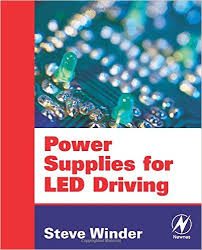دانلود کتاب Power Supplies LED Driving
Power Supplies LED Driving
The LED has been available for many years now, initially as a red colored indicator. Later, yellow/amber, green and finally blue colored LEDs became available, which triggered an explosion in applications. Applications included traffic lights, vehicle lights and wall-washes (mood lighting). Recently blue colored LEDs have been combined with yellow phosphor to create white light. The amount of light available from LEDs has also increased steadily, and now power levels of 1 W, 3 W and 5 W are fairly common. Driving a single LED, or a long string of LEDs connected in series, has relatively few problems when the current is low (may be 20 mA). High current LEDs are tougher to drive, requiring 350 mA, 700 mA, 1 A or higher. Of course, a simple linear regulator could be used if power dissipation was not an issue, or a simple resistor if current regulation is not critical. However, in most applications, an efficient switching regulator is used. A switching regulator is essential if the LED string voltage is higher than the supply voltage, or if the supply voltage has wide variation. But switching means that electro-magnetic interference (EMI) has to be considered too. Power Supplies LED Driving describes a number of LED driving methods. The main aims of this book are: (1) to show suitable types of LED driver topologies for given applications; (2) to work through some examples; and (3) to avoid some of the mistakes that some engineers make when creating their own designs. However, the content is not exhaustive and further reading in some peripheral topics will be necessary.
Light-emitting diodes are being widely used due to their efficient use of power. The applications for power LEDs include traffic lights, street lamps, automotive lighting, architectural lights, household light replacements, signage lighting (replacing neon strip lights and fluorescent tubes), and many more.
Powering (driving) these LED’s is not always simple. Linear driving is inefficient and generates far too much heat. With a switching supply, the main issues are EMI and efficiency, and of course cost. The problem is to get a design that meets legal requirements and is efficient, while costing the least. This book covers the design trade-offs involved in LED driving applications, from low-power to UB-LEDs and beyond.



